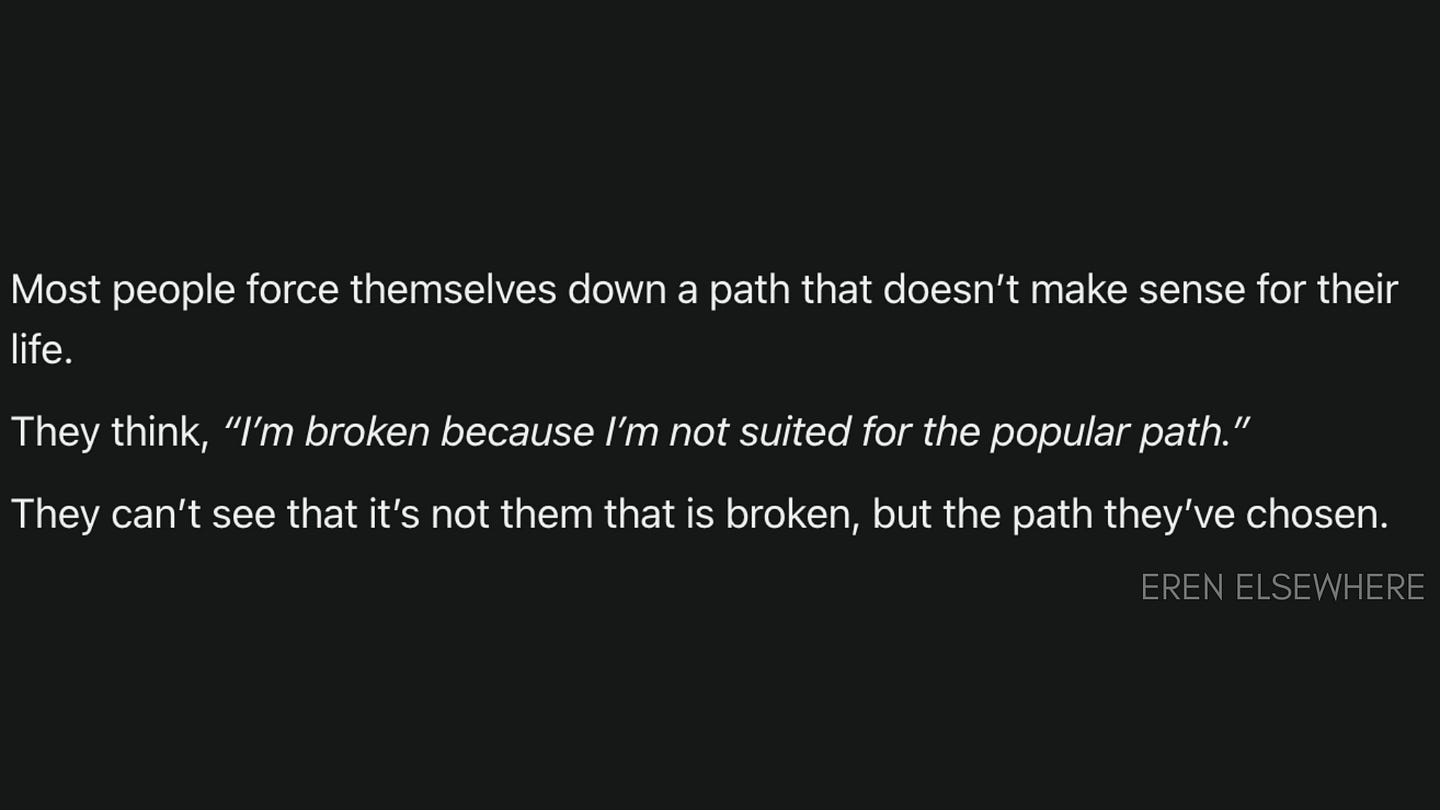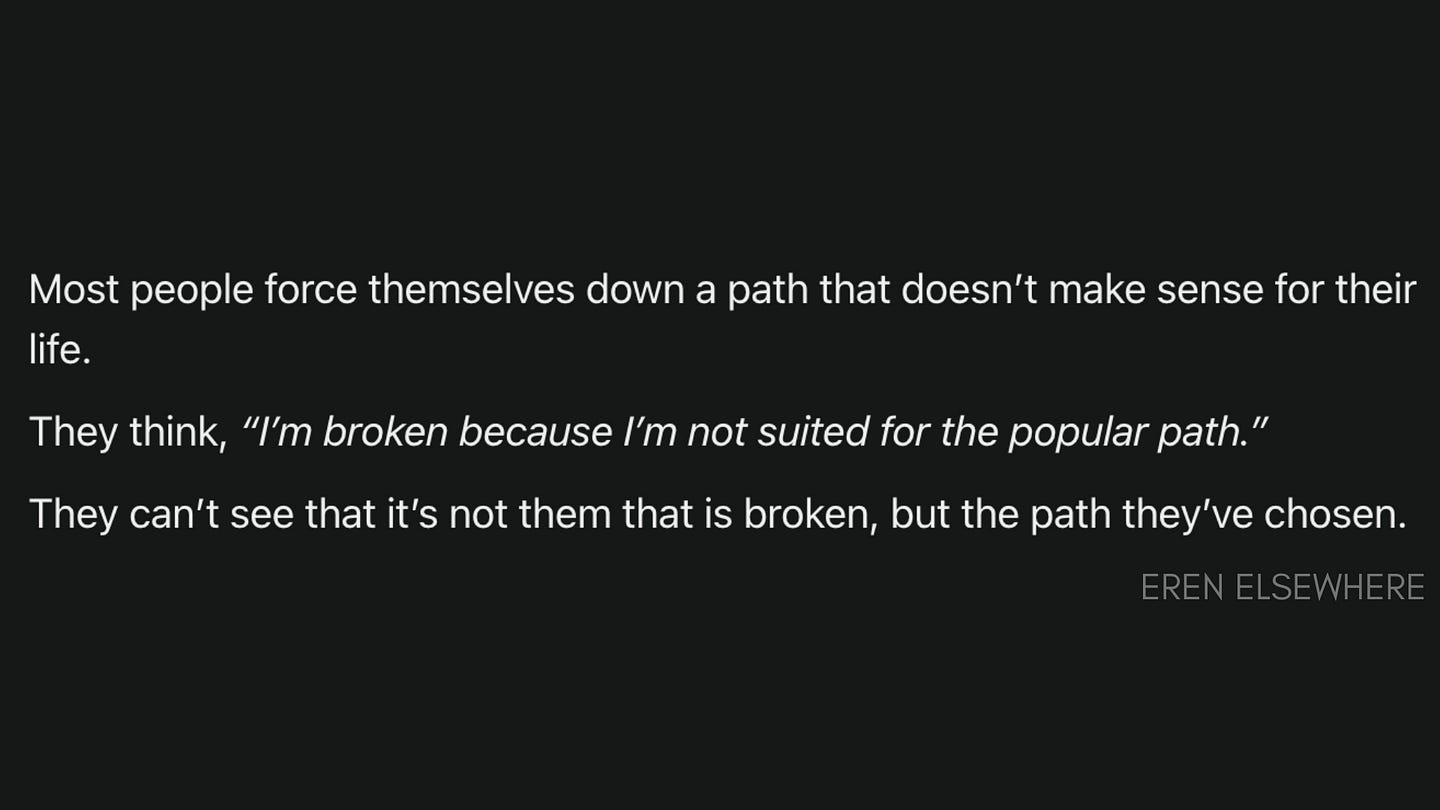You’re Spending Precious Time and Energy on the Wrong Path
The Art of Allowing — designing your dream life without the miserable grind
Everyone tells you that life is suffering.
And to some extent, that’s true.
But it took me way too long to realise that there are different kinds of suffering — some that are unavoidable, some that lead to positive results, and some that are downright stupid.
Mourning the death of a loved one — unavoidable.
Pushing through a difficult exercise or low point in life — positive.
Forcing yourself into a career, diet or exercise plan you never wanted — negative.
Focus on point 3 — this is the most destructive. Forcing your square-shaped self through a circular hole because you don’t deeply understand the Art of Allowing.
Because most people don’t realise that they don’t need to suffer to succeed.
A good life can feel like play.
If you hate what you’re doing, you’re doing the wrong thing
My first engineering job was in railways. I started at a time similar to someone called Tom G.
I thought Railways was it. I’d gotten my foot in the door. I was keen to learn, specialise and lock this in as a career path for myself. I knew it paid well, and it had heaps of sub-categories I could explore if I got bored.
I was like: “I’ve landed my dream job.”
One day, Tom G and I were having a concept explained to us by a master of Railway Engineering —a guy called Pavan.
But as he explained these concepts to us, I just could not focus.
I tried so hard because I wanted to understand what he was talking about. I desperately wanted to be a great railway engineer.
But I just couldn’t focus.
I was angry at myself in that moment because I knew I was wasting golden information.
Why won’t you focus? — I asked myself.
The bottom line:
I couldn’t focus because I didn’t care about what he was saying. Honestly, I didn’t give a shit about railways. And I never had.
The whole time I worked there, I tried to care and tried to convince myself I loved it to:
help the people I worked with
show respect for giving me a chance
build a good and stable career for myself
become good at something so I could end the search for passion
I felt like a failure. I felt lazy and dumb for not being interested, for not reading railway engineering textbooks and for not caring about my future career…
But then, Tom G asked a follow-up question to what Pavan was explaining….
I was like: Wait, he’s actually interested in this?! He’s following along?!
And that’s when I realised something transformative for my life.
I’m interested in many things — I can listen to podcasts and audiobooks for hours on those topics. I can even sit down in my spare time and study courses for hours on topics I find interesting.
But I’m just not interested in this.
And then it all started to make sense. When I’d talk to people about topics I was passionate about — like philosophy or mindset — some of them couldn’t care less. They’d rather talk about railways.
I’d think to myself, How can you not be interested?!
And for the first time in my life, I truly understood what people meant when they said, “Everyone is different.”
Not everyone is a train. Some people are motorbikes, some are cars, some are boats, planes, jet skis, bicycles…
Maybe I’m just not a train kinda guy…
And suddenly, the floodgates of life opened for me.
I realised that I didn’t have to punish myself and drag myself through the gauntlet to build my dream life — I learned the Art of Allowing (more on that to come).
People who study railway engineering textbooks for hours are interested in the topic and do so by choice — and that’s simply an interest I didn’t have.
All I had to do was allow myself to experiment with various paths until I found things that were relatively enjoyable to me — and double down on them.
The Art of Allowing — relaxing and letting the answer reveal itself
“When you try to see into the distance by narrowing your eyes and peering, you bring about a distortion of vision. So, in trying to get something out of life, you often defeat your own purpose.” — Alan Watts
The Art of Allowing is using gravity.
When you pour a glass of water down a path, it doesn’t force a path. It lets its own weight guide it.
That’s exactly what you need to do to find what works for you.
Don’t tunnel your way to a destination you think you need, especially if you don’t know what it is you want! You’re likely confused, so you want to be extremely high in the trait ‘openness’ for now — let things unfold as they will.
“Let go of who you think you’re supposed to be and embrace who you are.” — Brené Brown
People have these hypothetical grand ideas and then try to brute-force them to come true.
You see it all the time in health and fitness.
Like most people, when I was overweight and trying to lose weight, I tried all the extreme methods because I was extremely committed.
I know how it feels to pour your heart and soul into something because you want it so bad, but receive little to no reward because the process wasn’t designed for you.
You simply cannot sustain the extreme methods for long periods of time.
So you fizzle out. Resort to your old ways. It makes me emotional because I know that feeling so deeply.
But it all changed for me when I decided to use the Art of Allowing: to take the longer-term approach, take a deeper look within and design my life around my personality, strengths and weaknesses.
For example:
My weakness was I could not stop eating if food was in front of me — I would shovel whatever was on my plate until I was bursting at the seams.
Forcing — portion controlling meant being unsatisfied at every meal and snacking in between.
Allowing — cutting out breakfast entirely (which I didn’t mind) allowed me to eat as much as I wanted at dinner — I could do this long-term easily!I liked exercise, but there were certain types of exercise I hated so much that I would skip it.
Forcing — continue to hate my workouts, skipping days here and there.
Allowing — designing my workout regime around the exercises I enjoyed, keeping the workouts quite short, and incorporating sports I loved.
I could do this consistently!
I could’ve yelled at myself and forced myself to portion control and do some random person’s workout I found on the internet, but I would’ve burned out and never lost the weight.
But the Art of Allowing taught me to design a process that worked for ME, that aligned with MY GOALS and MY PREFERENCES so that the work could feel like play.
This is the best way to achieve any goal — consistency. But not just the discipline, not just whipping yourself into something you hate.
Creating a method that works for you so you can keep doing it without it feeling like a miserable grind.
5 steps to creating work that feels like play
In basketball, we have a phrase:
“Take what the defence gives you.”
Don’t charge your way into traffic and throw something up because you’re stubborn about a certain method.
Take what the defence gives you. If there’s a 7-footer waiting for you at the rim, stop and take a jump shot.
Allow yourself to follow the path of gravity, the “easy” path that you can effortlessly put hard work into.
Here are 5 steps to take what the defence gives you — to create a life where work feels like play:
1. Allow life to present you with options
Be open to all options. Try them out and see what you enjoy. Be fluid and relaxed in your openness to experiences and things.
You’re scanning the full range of opportunities with a metal detector until you hear that beep!
Your life will go in certain, unexpected directions. And you won’t be able to foresee how each pivot will benefit you, so trust the universe and try it anyway.
There are many parts of railway engineering, and those first workouts I did that I still incorporate in my life today — in fact they’re a huge part of why I am who I am.
Writing, for example. I was asked to write an article for the rail team back in 2021 — and I found it quite fun. I started to write about my self-improvement journey and here I am 3 years later!
2. Consciously reflect on each experience
What’s enjoyable to you? What parts of each experience do you dislike?
Experiment and follow your curiosity.
Continuing with the metal detector, it’s honing on on where the metal is. Once you hear the beeping get faster, you go in that direction until you’re right on top and you can invest ALL of your energy into that.
Take notice of what you like and don’t like about things (ie. which exercises do you like in the gym, do those). I remember I hated doing heavy squats, it felt horrible on my body. I pushed through for years and got injured several times.
Then, I decided to just do less weight and more reps — and I enjoyed it way more. Now I don’t resent it when it’s time to work on my legs, I look forward to it.
The same thing happened with running. I hated running and couldn’t believe I had to do that to be healthy. Until I realised I ran up and down a basketball court for hours on end without getting bored.
Ok…less running, more basketball. That works for me!
It’s so obvious, man!
3. Create processes and systems that are repeatable
Now that you’ve experimented, and figured out what you like/don’t like, it’s time to create repeatable systems and processes aligned to you.
Remember, for every preference you have, there is someone with the opposite preference! Georgia’s dream job is to stay home and talk to nobody — that’s my idea of torture!
Don’t do a 2-hour workout twice a week, do a 30-minute one four times a week if you prefer
Can’t sit still in an office all day? Find a job where you can go out to site and stay on your feet all day.
Create systems that you enjoy, where work doesn’t feel that hard. Where your natural curiosities have been leveraged.
4. Do them for a long time (but be open to pivoting)
The whole point is to create things you can sustain long-term. Do them for a long time and watch the compounding results.
But don’t be afraid to make pivots along the way as per step 1.
“You are under no obligation to be the same person you were five minutes ago.”
— Alan Watts
You might find a gym routine that works even better for you — feel free to experiment again.
5. Practice ‘allowing’ in moments of weakness
This is the most important step.
Large-scale allowing is one thing, but you gotta start small. This is how you build the capability to master the Art of Allowing.
Consciously take extra moments in “tight” situations to rebalance and breathe.
Remember the squinting quote → the harder you squint, the less you see. But relax, and you will see clearly.
Note: this is why a word is on the tip of your tongue and you can’t quite think of it… but as soon as you stop trying — boom — there it is!
Summary — invest in the right path for you
Don’t force your circular life through a square-shaped hole you deem ideal.
The Art of Allowing is witnessing your life, and playing into who you are, rather than forcing yourself to be something you’re not.
It makes life feel easy, even though there is no shortage of working hard.
It’s not that we don’t want to work. We just need to work at things that align with our souls.
You’re not broken, you’re just on the wrong path.
Allow life to present you with options — be open
Consciously reflect on experiences — what do you like/not like?
Create repeatable systems/processes — can you do this long-term?
Do it long term (but be open to changing path again)
Practice ‘allowing’ in everyday moments
I’ll leave you with a quote my dad told me years ago that I’ll never forget:
“Vidayı zorlama” → Don’t force the screw.
Thank you for reading!
Subscribe for more of my applicable self-improvement concepts to live better, and follow along as I build a course and workshop for people who want to level up their mindset and achieve the highest version of themselves in their lives and careers.










Very well written Eren! I enjoyed this piece & how you integrated your personal experience with health.
Thanks for sharing. You got me through a dull lecture about philosophy...